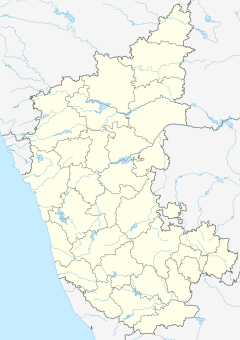Amba Vilas Palace
| Mysore Palace | |
|---|---|

Mysore Palace
|
|
|
Location within Karnataka
|
|
| General information | |
| Architectural style | Indo-Saracenic |
| Location | Inner Mysore |
| Town or city | Mysore |
| Country | India |
| Coordinates | 12°18′14″N 76°39′17″E / 12.3039°N 76.6547°E |
| Current tenants | Government of Karnataka |
| Construction started | 1897 |
| Completed | 1912 |
| Owner | Rajmata Pramoda Devi Wadiyar |
| Design and construction | |
| Architect | Henry Irwin |
| Designations | Royal Seat of the Maharajas of Mysore |
The Palace of Mysore (Kannada: ಮೈಸೂರು ಅರಮನೆ, translit. maisūru aramāne) is a historical palace in the city of Mysore in Karnataka, southern India. It is the official residence and seat of the Wodeyars — the rulers of Mysore, the royal family of Mysore, who ruled the princely state from 1399 to 1950. The palace houses two durbar halls (ceremonial meeting halls of the royal court) and incorporates an array of courtyards, gardens, and buildings. The palace is in the central region of inner Mysore, facing the Chamundi Hills eastward.
Mysore is commonly described as the City of Palaces. There are about seven palaces inclusive of this; however, Mysore Palace refers specifically to the one within the Old Fort. Built by the Maharaja Rajarshi His Highness Krishnarajendra Wadiyar IV, Mysore Palace is now one of the most famous tourist attractions in India, after the Taj Mahal, with more than 6 million annual visitors.
Krishnaraja Wadiyar III was Maharaja from 1799 to 1831. After the death of Tipu Sultan he made Mysore his capital in May 1799 and focused on education, religious sites and donating jewels to temples including Melkote. Chamaraja Wodeyar IX was crowned on 25 March 1881. He was anointed king on the date fixed by the Governor-General. He is credited with founding India's first democratic institutions -"Prajapratinidhi Sabhe" with the Mysore representative assembly in 1881. Nalwadi Krishnaraja Wodeyar IV was Maharaja from 1902 to 1940. He was also called the Saint King-"Rajarshi" by Mahatma Gandhi. Assisted by dewans Sir M. Visvesvaraya and Sir Mirza Ismail, he changed Mysore by adding Asia's first hydro electric project at Shivanasamudra, the KRS dam and the University of Mysore in 1916. Jayachamaraja Wodeyar was the twenty fifth and the last king, reigning from 1940 to 1950, when he agreed to merge the state with the union of India. A musicologist and a philanthropist, he was named Raj Parmukh of Mysore from 26 Jan 1950, a post he held for six years. The present Maharaja is Yaduveer Wadiyar, who was adopted by his aunt.
...
Wikipedia

